July 4th
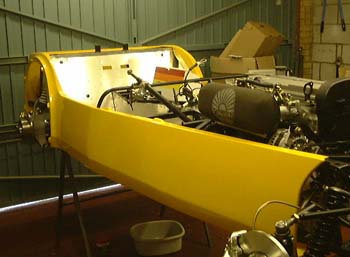 As
far as the formal Westfield rules are concerned, I've now finished modules 1 to 4, although there are lots of little
bits and pieces that I could fill in with, such as bleeding the brakes.
As
far as the formal Westfield rules are concerned, I've now finished modules 1 to 4, although there are lots of little
bits and pieces that I could fill in with, such as bleeding the brakes.
However, I reckoned that with a bit of fudging I could start on the next major bit, which involves fitting the bodywork. So, without much more ado we got the bodywork down from its eyrie. When we put it up there, I thought it was going to be there for months, it's managed just over four weeks.
The manual says that the first thing to do is to fit the wheelarches to the bodywork and then fit the rear lights to the body and wheelarches. As we don't yet have the lights, and because it seemed daft to fit the wheel arches before putting the bodywork on the car, we went ahead and fitted this rather flimsy glass fibre thing to the chassis.
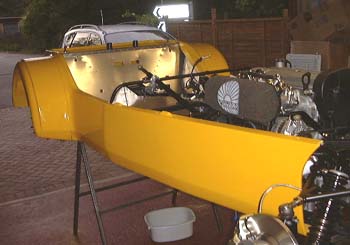 However,
it soon transpired that it really would be best to fit the arches first, so as to get more room to drill the mounting
holes. So, we took it off and put it on the drive, clamped the arches to the main body, drilled the holes, removed
the arches again, put the bodywork back on the chassis and bolted the arches to the bodywork.
However,
it soon transpired that it really would be best to fit the arches first, so as to get more room to drill the mounting
holes. So, we took it off and put it on the drive, clamped the arches to the main body, drilled the holes, removed
the arches again, put the bodywork back on the chassis and bolted the arches to the bodywork.
This is not quite according to the book, which says that you should attach the arches before putting the whole lot on the chassis. For us this was rather difficult as we found that the loss in flexibility that this produced made the bodywork hard to "clip" around the chassis. There is a comment in the build manual, together with an impossible to interpret diagram, that implies that some glass fibre has to be hacked away in order to make it fit properly and this may relate to our problem. However, our way seems better, at the moment.
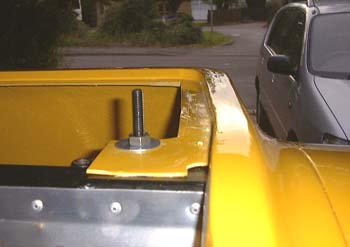 So,
the arches were attached to the rest of the bodywork with 20 (!) bolts and everything was aligned. (The measurements
in the build manual are amazingly precise for a load of floppy GRP.) Luckily, I managed to get Tom to put in all
the bolts and I stood around supervising.
So,
the arches were attached to the rest of the bodywork with 20 (!) bolts and everything was aligned. (The measurements
in the build manual are amazingly precise for a load of floppy GRP.) Luckily, I managed to get Tom to put in all
the bolts and I stood around supervising.
Everything was then clamped in place and the body riveted to the rear of the chassis. In order to do this, there has to be quite a lot of tension in the bodywork. As we did everything in the absence of the roll bar--this bolt is being used instead--I hope that when we do get the roll bar it won't all jump out of alignment. With luck I will be able to get by with a dozen G cramps or so instead.
We did a lot of today's work with the garage door open. It's amazing how many people walk very slowly past to get a better look. One kid nearly fell off his bike today, due to gawping so much that he ran into the kerb. I wonder if this is a harbinger of things to come when the car is on the road?
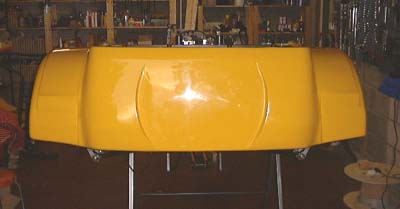 The
upshot of all this is that, at least from the back, the car is looking much more like a car. Actually, this perspective
is one of the reasons that I bought a Westfield, as it doesn't have the unpleasant "bent piece of tin"
appearance that many other sevenesque cars have.
The
upshot of all this is that, at least from the back, the car is looking much more like a car. Actually, this perspective
is one of the reasons that I bought a Westfield, as it doesn't have the unpleasant "bent piece of tin"
appearance that many other sevenesque cars have.
I hope I can fit the lights on here properly...
I've also been worrying about some un-identifiable components. There's a black glass fibre box and four small (about 300 mm long) strangely shaped and bent bits of aluminium. I have no idea what any of these bits are for.
July 6th
Westfield phoned to say that (most) of the rest of the bits are available for collection at the weekend. I'll go up on Saturday, with any luck for the last time!
July 9th
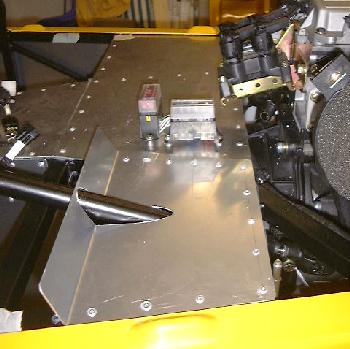 Fitted
the aluminium panel that goes above the driver's feet. I'm a bit concerned about this as I want to maintain access
to the pedals as I suspect that I might be able to get a bit more legroom there with a bit of fabrication. However,
I reckon that I'll be able to get in through the footwell. There's another access issue in that the lower mounting
for the upper steering columns is blocked by this plate. I inverted the bolts here so that they can be removed
from inside the footwell although it will take a lot of struggling.
Fitted
the aluminium panel that goes above the driver's feet. I'm a bit concerned about this as I want to maintain access
to the pedals as I suspect that I might be able to get a bit more legroom there with a bit of fabrication. However,
I reckon that I'll be able to get in through the footwell. There's another access issue in that the lower mounting
for the upper steering columns is blocked by this plate. I inverted the bolts here so that they can be removed
from inside the footwell although it will take a lot of struggling.
in case you've got to this frame directly and can't get out, go here.